小学英语教案全英文版
小学英语教案全英文版
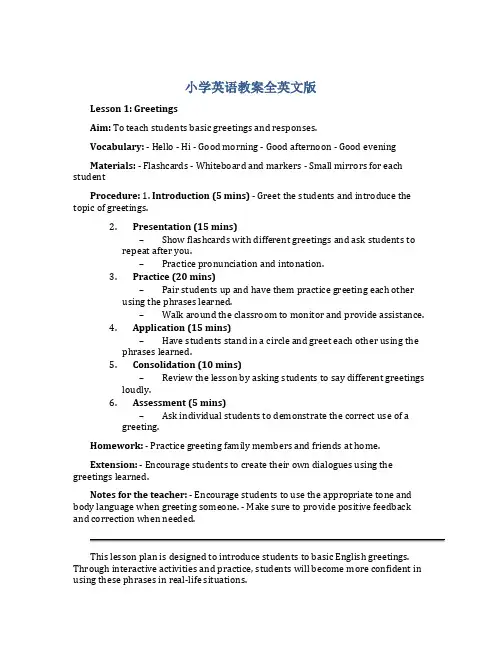
小学英语教案全英文版Lesson 1: GreetingsAim: To teach students basic greetings and responses.Vocabulary: - Hello - Hi - Good morning - Good afternoon - Good eveningMaterials: - Flashcards - Whiteboard and markers - Small mirrors for each studentProcedure: 1. Introduction (5 mins) - Greet the students and introduce the topic of greetings.2.Presentation (15 mins)–Show flashcards with different greetings and ask students to repeat after you.–Practice pronunciation and intonation.3.Practice (20 mins)–Pair students up and have them practice greeting each other using the phrases learned.–Walk around the classroom to monitor and provide assistance.4.Application (15 mins)–Have students stand in a circle and greet each other using the phrases learned.5.Consolidation (10 mins)–Review the lesson by asking students to say different greetings loudly.6.Assessment (5 mins)–Ask individual students to demonstrate the correct use of a greeting.Homework: - Practice greeting family members and friends at home.Extension: - Encourage students to create their own dialogues using the greetings learned.Notes for the teacher: - Encourage students to use the appropriate tone and body language when greeting someone. - Make sure to provide positive feedback and correction when needed.This lesson plan is designed to introduce students to basic English greetings. Through interactive activities and practice, students will become more confident in using these phrases in real-life situations.。
2024年新版小学英语教案英文完整版
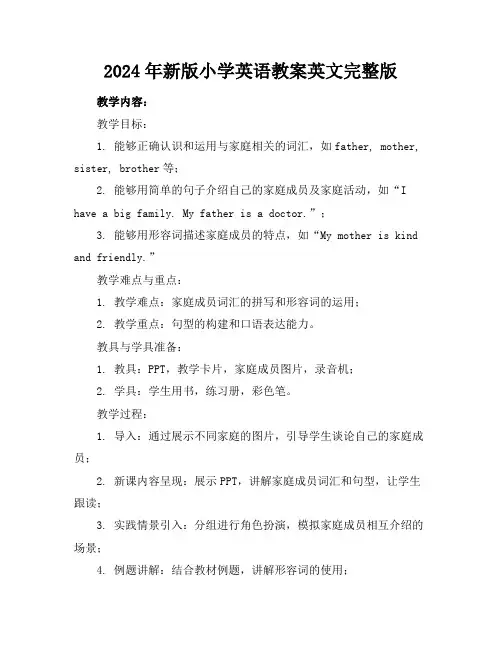
2024年新版小学英语教案英文完整版教学内容:教学目标:1. 能够正确认识和运用与家庭相关的词汇,如father, mother, sister, brother等;2. 能够用简单的句子介绍自己的家庭成员及家庭活动,如“I have a big family. My father is a doctor.”;3. 能够用形容词描述家庭成员的特点,如“My mother is kind and friendly.”教学难点与重点:1. 教学难点:家庭成员词汇的拼写和形容词的运用;2. 教学重点:句型的构建和口语表达能力。
教具与学具准备:1. 教具:PPT,教学卡片,家庭成员图片,录音机;2. 学具:学生用书,练习册,彩色笔。
教学过程:1. 导入:通过展示不同家庭的图片,引导学生谈论自己的家庭成员;2. 新课内容呈现:展示PPT,讲解家庭成员词汇和句型,让学生跟读;3. 实践情景引入:分组进行角色扮演,模拟家庭成员相互介绍的场景;4. 例题讲解:结合教材例题,讲解形容词的使用;5. 随堂练习:让学生用所学的词汇和句型进行口语练习;板书设计:1. My Family;2. 词汇:father, mother, sister, brother, grandpa, grandma等;3. 句型:I have a family. My is a ;4. 形容词:big, small, happy, kind, friendly等。
作业设计:1. 作业题目:请用今天学到的词汇和句型,写一段关于自己家庭的介绍;2. 答案示例:I have a happy family. My father is a doctor. He is very kind. My mother is a teacher. She is friendly to everyone. I also have a younger brother. He is very cute.课后反思及拓展延伸:1. 课后反思:关注学生在课堂上的表现,针对学生的薄弱环节进行针对性指导;2. 拓展延伸:鼓励学生用所学知识,与同学分享更多关于家庭的故事和活动。
小学英语的全英文教案范文
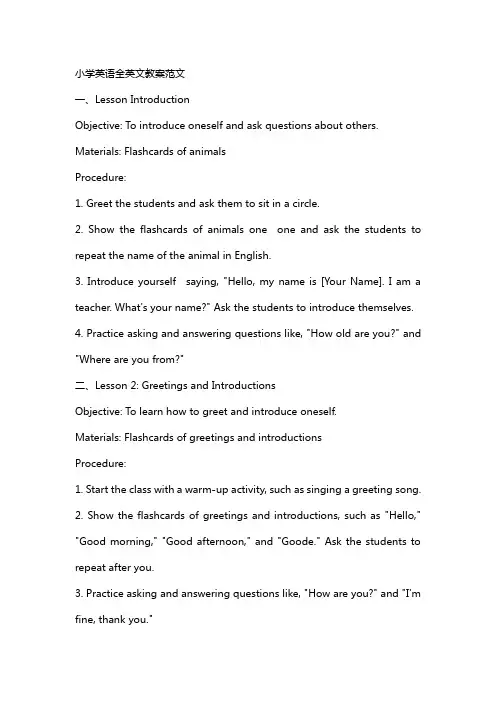
小学英语全英文教案范文一、Lesson IntroductionObjective: To introduce oneself and ask questions about others. Materials: Flashcards of animalsProcedure:1. Greet the students and ask them to sit in a circle.2. Show the flashcards of animals one one and ask the students to repeat the name of the animal in English.3. Introduce yourself saying, "Hello, my name is [Your Name]. I am a teacher. What's your name?" Ask the students to introduce themselves.4. Practice asking and answering questions like, "How old are you?" and "Where are you from?"二、Lesson 2: Greetings and IntroductionsObjective: To learn how to greet and introduce oneself.Materials: Flashcards of greetings and introductionsProcedure:1. Start the class with a warm-up activity, such as singing a greeting song.2. Show the flashcards of greetings and introductions, such as "Hello," "Good morning," "Good afternoon," and "Goode." Ask the students to repeat after you.3. Practice asking and answering questions like, "How are you?" and "I'm fine, thank you."4. Introduce a new student to the class and ask the students to greet and introduce themselves.三、Lesson 3: ColorsObjective: To learn how to name and describe colors in English. Materials: Flashcards of colorsProcedure:1. Start the class showing a colorful picture or object and ask the students to name the colors.2. Show the flashcards of colors one one and ask the students to repeat the color name in English.3. Practice describing colors using phrases like, "It's blue," "It's a red car," and "The sky is blue."4. Draw a colorful picture with the students and ask them to name the colors as you draw.四、Lesson 4: Numbers 1-10Objective: To learn how to count from 1 to 10 in English.Materials: Number flashcards, objects to countProcedure:1. Start the class counting with the students, "One, two, three, four, five." Continue counting up to 10.2. Show the number flashcards one one and ask the students to repeat the number in English.3. Give the students a set of objects, such as counters or toys, and ask them to count the objects using English numbers.4. Play a number game, such as "Simon Says" or "Number Memory," to reinforce the counting skills.五、Lesson 5: AlphabetObjective: To learn the English alphabet and the sounds of each letter. Materials: Alphabet flashcards, letter sounds chartProcedure:1. Start the class singing the "Alphabet Song" to familiarize the students with the English alphabet.2. Show the alphabet flashcards one one and ask the students to repeat the letter name in English.3. Expln the sounds of each letter in the alphabet using a letter sounds chart.4. Practice tracing the letters of the alphabet on a large whiteboard or chart paper, and ask the students to follow along.六、Lesson 6: Family MembersObjective: To learn how to name family members in English. Materials: Flashcards of family membersProcedure:1. Start the class asking the students about their family members in their native language.2. Introduce the concept of family members in English showing the flashcards of family members, such as "mother," "father," "brother," "sister," and "grandparent."3. Practice asking and answering questions about family members, like "Who is your mother?" and "I have a sister."4. Ask the students to bring a picture of their family and describe their family members in English.七、Lesson 7: Dly RoutinesObjective: To learn how to describe dly routines in English. Materials: Flashcards of dly routinesProcedure:1. Start the class discussing the dly routines of the students in their native language.2. Introduce the concept of dly routines in English showing the flashcards of dly routines, such as "wake up," "eat breakfast," "go to school," and "play."3. Practice asking and answering questions about dly routines, like "What do you do in the morning?" and "What do you do after school?"4. Ask the students to role-play their dly routines using English words and phrases.八、Lesson 8: ClothingObjective: To learn how to name and describe different types of clothingin English.Materials: Flashcards of clothingProcedure:1. Start the class discussing the types of clothing worn in different seasons.2. Introduce the concept of clothing in English showing the flashcards of different types of clothing, such as "shirt," "pants," "dress," "sunglasses," and "hat."3. Practice asking and answering questions about clothing, like "What are you wearing today?" and "I am wearing a skirt."4. Ask the students to bring a picture of themselves in different types of clothing and describe their clothing in English.九、Lesson 9: Food and DrinksObjective: To learn how to name and describe different foods and drinks in English.Materials: Flashcards of food and drinksProcedure:1. Start the class discussing the types of food and drinks liked the students.2. Introduce the concept of food and drinks in English showing the flashcards of different food and drink items, such as "apple," "banana," "orange," "milk," and "water."3. Practice asking and answering questions about food and drinks, like "What is your favorite fruit?" and "Can I have some water, please?"4. Ask the students to bring a picture of their favorite food or drink and describe it in English.十、Lesson 10: Review and AssessmentObjective: To review the topics covered in the previous lessons and assess the students' understanding.Materials: Review worksheets, flashcardsProcedure:1. Start the class reviewing the topics covered in the previous lessons, such as greetings, introductions, colors, numbers, family members, dly routines, clothing, food and drinks.2. Conduct a mini-assessment to evaluate the students' understanding asking them to answer questions related to the topics.3. Use flashcards to test the students' vocabulary retention asking them to name the items in English.4. Provide review worksheets for the students to plete, which include exercises like fill in the blanks, match the words with their pictures, and write short sentences using the learned vocabulary.5. Give feedback to the students on their performance and encourage them to continue practicing their English skills.重点和难点解析一、Lesson Introduction重点关注环节:Students' ability to ask and answer questions about themselves.难点解析:This lesson introduces the concept of asking and answering questions about oneself, which is a fundamental skill in language learning. The students may find it challenging to express their personal information accurately and confidently in English.二、Lesson 2: Greetings and Introductions重点关注环节:Students' ability to use greetings and introduce themselves.难点解析:Using proper greetings and introductions is crucial in dly munication. The students might struggle with remembering and applying the correct phrases in different situations.三、Lesson 3: Colors重点关注环节:Students' ability to name and describe colors in English. 难点解析:Naming and describing colors can be challenging for students, especially those whose native language does not use the same color palette as English.四、Lesson 4: Numbers 1-10重点关注环节:Students' ability to count from 1 to 10 in English.难点解析:Counting is a foundational math skill that can be difficult for students to master when learning a new language, as it involvesunderstanding the numerical system and sequencing.五、Lesson 5: Alphabet重点关注环节:Students' ability to recognize and pronounce each letter of the English alphabet.难点解析:The English alphabet may have letters that are not present in the students' native language, making it challenging for them to recognize and pronounce them correctly.六、Lesson 6: Family Members重点关注环节:Students' ability to name family members in English and ask about others'.难点解析:Understanding and using family vocabulary can be emotional and personal for students. They may find it difficult to remember the English words for extended family members or to ask about others' families.七、Lesson 7: Dly Routines重点关注环节:Students' ability to describe their dly routines in English. 难点解析:Describing routines involves sequencing and using past tense verbs, which can be plex for beginners to grasp.八、Lesson 8: Clothing重点关注环节:Students' ability to name and describe different types of clothing in English.难点解析:Clothing terms can be abstract and may not have directtranslations in students' native languages. Additionally, students may be self-conscious about discussing their attire.九、Lesson 9: Food and Drinks重点关注环节:Students' ability to name and describe different foods and drinks in English.难点解析:Food and drink vocabulary can be extensive, and students may have difficulty remembering the names of specific items or describing preferences.十、Lesson 10: Review and Assessment重点关注环节:Students' ability to review and apply the knowledge gned from the previous lessons.难点解析:Assessment can be stressful for students, especially if they feel unprepared. Ensuring that the review is prehensive and allows for individualized learning is crucial.这些教案环节涵盖了从自我介绍到日常生活中的各种主题,每个环节都有其特定的重点和难点。
全英版小学英语教案【三篇】
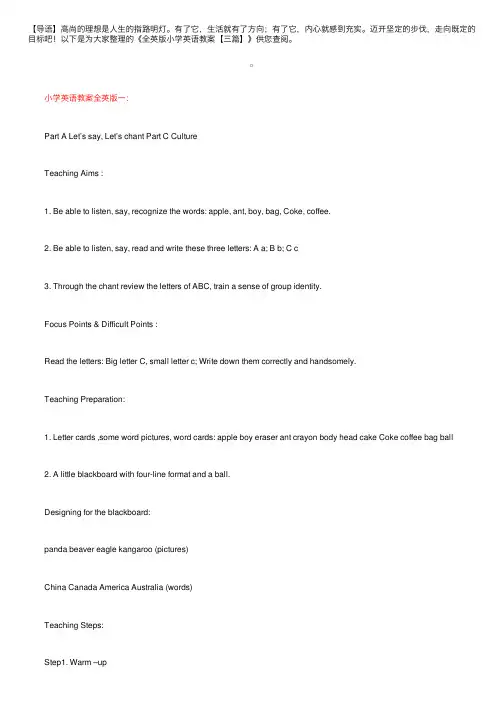
【导语】⾼尚的理想是⼈⽣的指路明灯。
有了它,⽣活就有了⽅向;有了它,内⼼就感到充实。
迈开坚定的步伐,⾛向既定的⽬标吧!以下是为⼤家整理的《全英版⼩学英语教案【三篇】》供您查阅。
⼩学英语教案全英版⼀: Part A Let’s say, Let’s chant Part C Culture Teaching Aims : 1. Be able to listen, say, recognize the words: apple, ant, boy, bag, Coke, coffee. 2. Be able to listen, say, read and write these three letters: A a; B b; C c 3. Through the chant review the letters of ABC, train a sense of group identity. Focus Points & Difficult Points : Read the letters: Big letter C, small letter c; Write down them correctly and handsomely. Teaching Preparation: 1. Letter cards ,some word pictures, word cards: apple boy eraser ant crayon body head cake Coke coffee bag ball 2. A little blackboard with four-line format and a ball. Designing for the blackboard: panda beaver eagle kangaroo (pictures) China Canada America Australia (words) Teaching Steps: Step1. Warm –up 1. Sing a song. 2. Free talk T: Hello. I’m Wendy. I’m from Hangzhou. S1: Hello! I’m ... I’m from Hangzhou,too. T: Nice to meet you. S: Nice to meet you, too. T: Let’s play. Ok? S: Great! T: Watch out! (T throws the ball.) S: Oh, no. Make a similar dialogue with your partner. Step2.Presentation. 1. 1)T : Today, we will learn letters. Do you know letters? Just as A,B,C…… They are letters. What’s the meaning of letters? S: 字母。
PEP人教版小学英语六年级上册(全英)教案
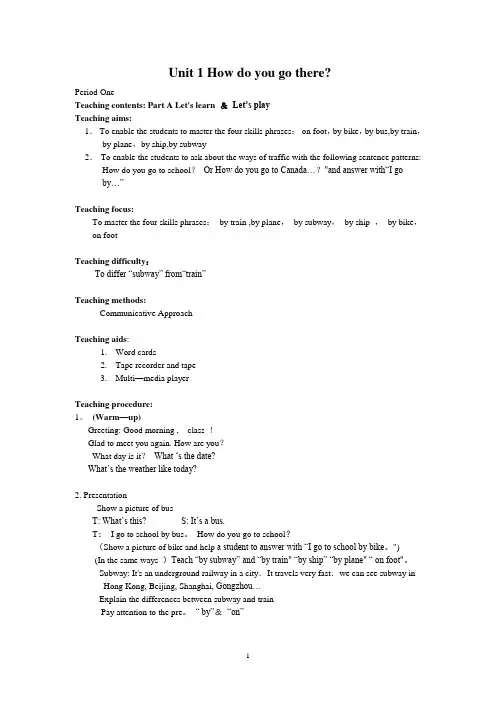
Unit 1 How do you go there?Period OneTeaching contents: Part A Let's learn &Let’s playTeaching aims:1.To enable the students to master the four skills phrases:on foot,by bike,by bus,by train,by plane,by ship,by subway2.To enable the students to ask about the ways of traffic with the following sentence patterns: How do you go to school?Or How do you go to Canada…?"and answer with“I goby…”Teaching focus:To master the four skills phrases:by train ,by plane,by subway,by ship ,by bike,on footTeaching difficulty:To differ “subway” from“train”Teaching methods:Communicative ApproachTeaching aids:1.Word cards2.Tape recorder and tape3.Multi—media playerTeaching procedure:1。
(Warm—up)Greeting: Good morning , class !Glad to meet you again. How are you?What day is it?What ‘s the date?What’s the weather like today?2. PresentationShow a picture of busT: What’s this? S: It’s a bus.T:I go to school by bus。
2024新版小学英语教案英文完整版

2024新版小学英语教案英文完整版一、教学内容本节课选自2024新版小学英语教材第五单元,主题为“Family and Friends”。
具体内容包括:Chapter 1 – Introducing Family Members, Section 1 – Meeting the Family,详细介绍家庭成员的称呼和相关句型。
二、教学目标1. 学生能够听懂、会说、会读家庭成员的英文称呼,如mom, dad, sister, brother等。
2. 学生能够运用所学句型介绍自己的家庭成员。
3. 学生能够通过小组合作,完成关于家庭成员的对话表演。
三、教学难点与重点重点:家庭成员的英文称呼和相关句型的运用。
难点:如何引导学生运用所学知识进行真实场景的对话表演。
四、教具与学具准备1. 教具:PPT、教学卡片、录音机、磁带。
2. 学具:学生用书、练习册、彩色笔。
五、教学过程1. 导入(5分钟)a. 播放一首关于家庭的英文歌曲,引导学生关注家庭主题。
b. 通过提问方式引导学生回顾已学的家庭相关词汇。
2. 新课内容展示(15分钟)a. 教师展示PPT,呈现家庭成员的图片和英文称呼。
b. 教师引导学生跟读,确保发音正确。
c. 教师通过例句展示如何运用所学句型介绍家庭成员。
3. 课堂互动(10分钟)a. 学生两人一组,进行角色扮演,互相介绍家庭成员。
b. 教师巡回指导,纠正发音和语法错误。
4. 例题讲解与随堂练习(10分钟)a. 教师呈现例题,讲解解题思路。
b. 学生独立完成练习,教师提供个别辅导。
5. 小组合作(10分钟)a. 学生四人一组,根据给定场景编写关于家庭成员的对话。
b. 每组进行表演,其他同学进行评价。
a. 教师带领学生回顾本节课所学内容。
b. 学生分享学习心得,教师给予鼓励和指导。
六、板书设计1. Family and Friends2. 主要内容:Family Members: mom, dad, sister, brother, grandpa, grandmaSentence Patterns: This is my , He/She is my七、作业设计1. 作业题目:a. 根据所学内容,介绍自己的家庭成员,不少于5句话。
英文教案小学全英模板
英文教案小学全英模板
一、教学目标
•通过本节课的学习,学生将能够掌握…
•学生将能够运用所学知识,进行…
二、教学重点
•掌握…
•理解…
三、教学准备
•教材:…
•教具:…
•…
四、教学过程
第一部分:导入
•利用图片或实物引入新课内容,激发学生兴趣。
第二部分:新课讲解
1.单词学习:学生通过图片、音频等多种方式学习新单词。
2.语法讲解:通过例句讲解新的语法知识。
第三部分:练习与巩固
1.课堂练习:设计多种类型的练习题,巩固学生对知识点的理解。
2.小组活动:学生分小组展开活动,提高语言运用能力。
第四部分:拓展延伸
•提出拓展问题,激发学生思维,拓展课外阅读。
五、教学反馈
•对学生表现进行评价,及时纠正学生错误,鼓励正确表现。
六、家庭作业
•布置相应的作业,巩固本节课所学内容。
七、教后反思
•总结本节课教学过程,查找不足并设想改进方法。
这个教案模板旨在帮助老师规划和设计一堂全英文的小学英语课程,灵活运用各种教学方法,提高学生的学习兴趣和语言运用能力。
希望能为您的英语教学提供一定的参考价值。
小学五年级英语上册教案全英文版5篇
小学五年级英语上册教案全英文版5篇小学五年级英语上册教案全英文版篇1教学目标与要求1、能听、说、认、读,并理解本课的五个新单词:young, old , funny, kind;strict2、能掌握句型:who’s your… what’s he /she like 并能在具体的语境中运用;3、培养学生热爱、尊敬老师的情感。
教学重点let’s learn部分的单词:old,short thin,tall,strong, young, funny, kind等。
要求学生能听懂句型,并结合这些句子表达的情境,学会恰当地替换句中的单词。
逐步学会听、说、读、写单词:old,short,thin,tall,strong。
教学难点如何利用所提供的对话和情景,以旧引新,让学生进入学习状态。
let’s start部分在学生用书当中首次出现,教师应正确理解此部分的辅垫作用,可根据实际教学需要进行使用,并帮助学生熟悉教材内容的变化。
教学准备1、准备教学过程中所需要的图片、声音、课件,以及本课时的八张单词卡;2、准备一些教师的照片或图片;3、准备录音机及录音带。
教学方法小组合作法、情景教学法1、warm-up(热身)(l) 播放let’s start下面歌谣的录音,让学生听歌谣猜单元话题,激发学生对新学期第一单元英语学习的兴趣。
还可以使用四年级上册第三单元学过的句型:“i have a new friend. he’s tall. he’s strong,too.”并结合相关人物的图片,引导学生复习 strong, tall, short,thin等词,为本课时听、说、读、写这些单词做好准备。
(2)日常口语练习,内容可参考如下:t:hello, everyone! welcome back to school! nice to see you!ss: nice to meet you!(3) 问学生几个问题,引出本课重点内容。
小学英语教案模板全英
小学英语教案模板全英【篇一:小学英语教案模板汇编(全册精选)】小学英语教案模板汇编(全册精选)【对于英语学科专业在事业单位教师、普岗教师、昆明教师、特岗教师面试说课或试或教师资格试讲中,到底是使用全英文的,还是可以使用汉语的,是所有考试面试的学生所纠结的一个问题,育萃面试为您提供了不同的案例。
其实不在乎你使用什么形式的说课稿或教案,关键是你是否运用的熟练。
在面试考试中,注意】《unit2 colours》教案一、教学目标能正确把握表示颜色的单词。
二、教学重点、难点能正确把握表示颜色的单词。
三、教学预备颜色纸或各种实物、单词卡片四、教学过程step 1 revision1.教师出第一课时的三个句型认读。
2.t: what’s this?s: it’s a book.t: what are these?ss: books.t: how many books?s: ??t: is it blue?s: yes.t: is it red?s: no.继续换几种物品提问。
3.出示第二课时的句型订读。
step 2 presentation1.教师拿出红、绿两种颜色纸: what colour is it?复习巩固red/ blue,并且认读。
2.教师拿出黄色纸:is it red? is it blue?教学yellow。
教师拿出一片叶子教学green教师拿出一个自制的红绿灯教学一首小诗:red, red stop;yellow yellow wait;green green go go go!3. t show an orange: what’s this ? it’s an orange. what colour is it? it’s orange.t: orange is orange.4.show a peach:what colour is it? it’s pink.教学粉红色。
5. show a chocolate: what colour is it? it’s brown.教学棕色。
小学英语教案20篇英文版
小学英语教案20篇英文版小学英语教学是教育的基础,也是每一个孩子学习英语的开端。
为了帮助小学英语老师更好地开展教学工作,提高孩子的英语学习成绩,以下是20篇小学英语教案的英文版,供广大小学英语教师参考。
1. Title: Introducing MyselfContent: Students learn to introduce themselves in English.Objectives: By the end of the class, students should be able to introduce themselves inEnglish.Materials: PPT, pictures, handoutsProcedure:1. Warm-up: Greeting students and asking them about their names.2. Presentation: Using pictures to introduce oneself and providing examples.3. Practice: Students practice introducing themselves in pairs.4. Production: Students present themselves in front of the class.5. Evaluation: Checking students’ pronunciation and fluency.2. Title: ColorsContent: Students learn how to recognize and say different colors in English.Objectives: By the end of the class, students should be able to recognize and name different colors in English.Materials: PPT, flashcards, handoutsProcedure:1.Warm-up: Using colored flashcards to engage students.2. Presentation: Using PPT to show pictures of different colors and their names.3. Practice: Students match the colors with their names and practice saying them.4. Production: Students createtheir own pictures and describe them in English.5. Evaluation: Checking students’ ability to recognize and name different colors.3. Title: NumbersContent: Students learn how to recognize and say the numbers from 1 to 20 in English.Objectives: By the end of the class, students should be able to recognize and say the numbers from 1 to 20 in English.Materials: PPT, flashcards, handoutsProcedure:1. Warm-up: Using number flashcards to engage students.2. Presentation: Using PPT to show pictures of the numbers from 1 to 20 and their names.3. Practice: Students match the numbers with their names and practice saying them.4. Production: Students practice counting in English and count the number of objects in the classroom.5. Evaluation: Checking students’ ability to recognize and say the numbers from 1 to 20.4. Title: ShapesContent: Students learn how to recognize and name different shapes in English.Objectives: By the end of the class, students should be able to recognize and name different shapes in English.Materials: PPT, flashcards, handoutsProcedure:1. Warm-up: Using shape flashcards to engage students.2. Presentation: Using PPT to show pictures of different shapes and their names.3. Practice: Students match the shapes with their names and practice saying them.4. Production: Students create their own pictures using different shapes and describe them in English.5. Evaluation: Checki ng students’ ability to recognize and name different shapes.5. Title: FamilyContent: Students learn how to talk about their family members in English.Objectives: By the end of the class, students should be able to talk about their family members in English.Materials: PPT, flashcards, handoutsProcedure:1.Warm-up: Asking students about their family members.2. Presentation: Using PPT to show pictures of different family members and their names.3. Practice: Students practice talking about their family members in pairs.4. Production: Students present their family members in front of the class.5. Evaluation: Checking students’ ability to talk about their family members in English.6. Title: AnimalsContent: Students learn how to recognize and name different animals in English.Objectives: By the end of the class, students should be able to recognize and name different animals in English.Materials: PPT, flashcards, handoutsProcedure:1. Warm-up: Using animal flashcards to engage students.2. Presentation: Using PPT to show pictures of different animals and their names.3. Practice: Students match the animals with their names and practice saying them.4. Production: Students create their own pictures using different animals and describe them in English.5. Evaluation: Chec king students’ ability to recognize and name different animals.7. Title: WeatherContent: Students learn how to recognize and name different types of weather in English.Objectives: By the end of the class, students should be able to recognize and name different types of weather in English.Materials: PPT, flashcards,handoutsProcedure:1. Warm-up: Asking students about the weather outside.2. Presentation: Using PPT to show pictures of different types of weather and their names.3. Practice: Students practice recognizing and naming different types of weather.4. Production: Students describe the weather in a particular place.5. Evaluation: Checking students’ ability to recognize and name different types of weather.8. Title: Food and DrinksContent: Students learn how to recognize and name different types of food and drinks in English.Objectives: By the end of the class, students should be able to recognize and name different types of food and drinks in English.Materials: PPT, flashcards, handoutsProcedure:1.Warm-up: Asking students about their favorite food and drinks.2. Presentation: Using PPT to show pictures of different types of food and drinks and their names.3. Practice: Students practice recognizing and naming different types of food and drinks.4. Production: Students decide on a menu and describe the food and drinks in English.5. Evaluation: Checking students’ ability to recognize and name different types of food and drinks.9. Title: My BodyContent: Students learn how to recognize and name different parts of the body in English.Objectives: By the end of the class, students should be able to recognize and name different parts of the body in English.Materials: PPT, flashcards, handoutsProcedure:1. Warm-up: Asking students about different parts of the body.2. Presentation: Using PPT to show pictures of different parts of the body and their names.3. Practice: Studentspractice recognizing and naming different parts of the body.4. Production: Students draw a person and label the different parts of the body in Eng lish.5. Evaluation: Checking students’ ability to recognize and name different parts of the body.10. Title: JobsContent: Students learn how to recognize and name different types of jobs in English.Objectives: By the end of the class, students should be able to recognize and name different types of jobs in English.Materials: PPT, flashcards, handoutsProcedure:1. Warm-up: Asking students about their dream job.2. Presentation: Using PPT to show pictures of different types of jobs and their names.3. Practice: Students practice recognizing and naming different types of jobs.4. Production: Students choose a job and describe it in English.5. Evaluation: Checking students’ ability to recognize and name different types of jobs.11. Title: Days of the WeekContent: Students learn how to recognize and say the days of the week in English.Objectives: By the end of the class, students should be able to recognize and say the days of the week in English.Materials: PPT, flashcards, handoutsProcedure:1. Warm-up: Asking students about their favorite day of the week.2. Presentation: Using PPT to show pictures of the days of the week and their names.3. Practice: Students practice recognizing and saying the days of the week.4. Production: Students describe their schedule for the week.5. Evaluation: Checking students’ ability to recognize and say the days of the week.12. Title: Months of the YearContent: Students learn how to recognize and say the months of the year in English.Objectives: By the end of the class, students should be able to recognize and say the months of the year in English.Materials: PPT, flashcards, handoutsProcedure:1. Warm-up: Asking students about their favorite month of the year.2. Presentation: Using PPT to show pictures of the months of the year and their names.3. Practice: Students practice recognizing and saying the months of the year.4. Production: Students describe their favorite season and the months that belong to it.5. Evaluation: Checking students’ ability to recognize and say the months of the year.13. Title: TimeContent: Students learn how to tell the time in English.Objectives: By the end of the class, students should be able to tell the time in English.Materials: PPT, flashcards, handoutsProcedure:1. Warm-up: Asking students about their favorite time of the day.2. Presentation: Using PPT to show pictures of the clock and different times.3. Practice: Students practice telling the time in English.4. Production: Students plan their daily schedule and write it in English.5. Evaluation: Checking students’ ability to tell the time in English.14. Title: Weather ForecastContent: Students learn how to give a weather forecast in English.Objectives: By the end of the class, students should be able to give a weather forecast in English.Materials: PPT, flashcards, handoutsProcedure:1.Warm-up: Asking students about the weather outside.2. Presentation: Using PPT to show different weather conditions andvocabulary.3. Practice: Students practice giving a weather forecast in pairs.4. Production: Students give a weather forecast in front of the class.5. Evaluation: Checking students’ ability to give a weather forecast in English.15. Title: SeasonsContent: Students learn how to recognize and name the different seasons in English.Objectives: By the end of the class, students should be able to recognize and name the different seasons in English.Materials: PPT, flashcards, handoutsProcedure:1. Warm-up: Asking students about their favorite season.2. Presentation: Using PPT to show pictures of the different seasons and their names.3. Practice: Students practice recognizing and naming the different seasons.4. Production: Students write a paragraph about their favorite season in English.5. Evaluation: Checking students’ ability to recognize and name the different seasons in English.16. Title: ToysContent: Students learn how to recognize and name different types of toys in English.Objectives: By the end of the class, students should be able to recognize and name different types of toys in English.Materials: PPT, flashcards, handoutsProcedure:1. Warm-up: Asking students about their favorite toy.2. Presentation: Using PPT to show pictures of different types of toys and their names.3. Practice: Students practice recognizing and naming different types of toys.4. Production: Students describe their favorite toy in English.5. Evaluation: Checking students’ ability to recognize and name different types of toys.17. Title: School SuppliesContent: Students learn how to recognize and name different school supplies in English.Objectives: By the end of the class, students should be able to recognize and name different school supplies in English.Materials: PPT, flashcards, handoutsProcedure:1. Warm-up: Asking students about their favorite school supply.2. Presentation: Using PPT to show pictures of different school supplies and their names.3. Practice: Students practice recognizing and naming different school supplies.4. Production: Students describe the contents of their school bag in English.5. Evaluation: Checking students’ ability to recognize and name different school supplies.18. Title: Parts of a HouseContent: Students learn how to recognize and name different parts of a house inEnglish.Objectives: By the end of the class, students should be able to recognize and name different parts of a house in English.Materials: PPT, flashcards, handoutsProcedure:1.Warm-up: Asking students about the different rooms in their house.2. Presentation: Using PPT to show pictures of different parts of a house and their names.3. Practice: Students practice recognizing and naming different parts of a house.4. Production: Students describe their favorite room in their house in English.5. Evaluation: Checking students’ ability to recognize and name different parts of a house.19. Title: HolidaysContent: Students learn how to recognize and name different holidays in English.Objectives: By the end of the class, students should be able to recognize and name differentholidays in English.Materials: PPT, flashcards, handoutsProcedure:1. Warm-up: Asking students about their favorite holiday.2. Presentation: Using PPT to show pictures of different holidays and their names.3. Practice: Students practice recognizing and naming different holidays.4. Production: Students write about their favorite holiday in English.5. Evaluation: Checking students’ ability to recognize and name different holidays in English.20. Title: SportsContent: Students learn how to recognize and name different sports in English.Objectives: By the end of the class, students should be able to recognize and name different sports in English.Materials: PPT, flashcards, handoutsProcedure:1. Warm-up: Asking students about their favorite sport.2. Presentation: Using PPT to show pictures of different sports and their names.3. Practice: Students practice recognizing and naming different sports.4. Production: Students describe their favorite sport in English.5. Evaluation: Checking students’ ability to recognize and name different sports in English.以上是20篇小学英语教案的英文版,它们覆盖了小学英语教学的各个方面。
- 1、下载文档前请自行甄别文档内容的完整性,平台不提供额外的编辑、内容补充、找答案等附加服务。
- 2、"仅部分预览"的文档,不可在线预览部分如存在完整性等问题,可反馈申请退款(可完整预览的文档不适用该条件!)。
- 3、如文档侵犯您的权益,请联系客服反馈,我们会尽快为您处理(人工客服工作时间:9:00-18:30)。
小学英语教案全英文版
小学英语教案全英文版篇一
Ⅰ.Teaching objectives nguage functions: Talking about animals and their favorite food. 2. Language structures: I like… 3. New vocabulary: Monkey, elephant, rabbit, panda, goat 4. Skills: Listening: 能听懂各种动物的名称及其习性的内容,-go to the zoo。
Speaking: 能运用所学的单词句型谈论各种动物的习性 5. Teaching activities: (1). Role play: Elephant 生日请客,分食物给他的朋友们并说”I like…”T-elephant Ss-monkey, rabbit, panda, goat (2). A game: Looking for good friends 让学生自取道具找朋友,如当T说1,2,3后拿carrot的要与拿rabbit的站到一块并说We are good friends. Ⅱ.Teaching key points and difficult points 1.The sounds of the new words. 2.Freely using the sentences. Ⅲ.Teaching aids 课件,a big picture (animals party), 10 small pictures (monkey, elephant, rabbit, panda, goat, bananas, grass, carrots, bamboo, leaves)Ⅳ.Teaching procedure 1. Greeting 2. Sing a song: one two three song 3. say goodbye to the 1, 2, 3 and go to the zoo T: We
are going to the zoo today. Therere many animals at the zoo. T introduces animals by action and sound, show animals pictures and put them on the big picture, and teach their names. ( 使用课件Part 1 ) 4. Review food names and teach “ I like…” (使用课件Part 2 ) (1). T act as the elephant, tell Ss “today is my birthday, I have food and Ill give them to my friends “( T shows food pictures and Ss review) (2).role play: T act as the elephant first and teach “ I like…”, and then find my friends( Ss) to play and practice the sentences. 5. CA: T shows pictures, Ss practice the sentences 6. PA: Ss use their food to practice the sentences 7. A game: Looking for good friends ( moral education: We are friends, we should take good care of each other.) (1). 先找S1配合示范: T在B上找到monkey的图片, S1找到bananas 的图片, T and Ss say “ were good friends”, ask Ss to play. (2). 对对碰:Let 10Ss hold 10 pictures, when T say 1, 2, 3 , Ss should find their friends at once.
8. Sing a song: two little black birds ( 使用课件Part 3 ) 9. Sum up (使用课件Part 1 and 2 )小学英语教案全英文版篇二
Teaching objectives: 1.It looks like ____.
2.cloud , sky
3.lie .Danny goes to the park, we
should clear about its meaning. It’s fun and happy, if you have time you can go out to play after you have finished your words. The nature is clear and vivid, clean air, green trees and leaves, white clouds, beautiful flowers. We can go out share it. Teaching focal points: 1.how to use “look like”2.lie Teaching difficulty points:1.how to use “look like”2.lie Teaching aims: A tape A big picture of the dialogue Teaching steps:Class opening and review Review “flowers”“leaves”“grass” with a drill. Choose a drill from “Teaching Techniques”Introduce Demonstrate “cloud” and “sky” with your poster, or by pointing out the window of your classroom. Draw quick pictures of clouds on the blackboard. Make the clouds look like something. Say phrases such as: Use a puppet to introduce the word “lie” For example, draw quick pictures of a bed and some grass on the blackboard. Make the puppet “lie”on these as you say phrases for it such as: I am tired.
I want to sleep. Where can I sleep? Here’s a bed.
I am going to lie on the bed. Now I am lying on the bed. I don’t want to sleep here! Here’s some grass. Now I am lying on the grass. Now I can see the sky! Practice Divide the class into small
groups. Ask each group to make up a dialogue about lying on the grass and looking at clouds in the sky. Please read about making up dialogues in “Teaching Techniques”Play “Go Fish” or “Memory Card” with the students’flashcards for the following words: cloud, sky, flowers, leaves, grass, snow, ice, rain, sun and wind. Use the activity book Number 2 in the activity book is a listening exercise on the audiotape as follows: Listen, draw the shapes and write the words. a triangle b. line c. circle d. square Blackboard show: Lesson19:Let’s go to the park lie on cloud sky It looks like _________ .。
